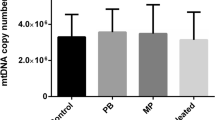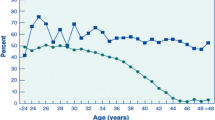Abstract
Purpose
The effects of reciprocal transplantation of meiosis-II chromosomes between senescent and young mouse oocytes were evaluated based on pre- and post-implantation development ability of resultant embryos.
Methods
Karyoplasts including meiosis-II chromosomes of oocytes from senescent Rockefeller mouse/Ms-Rb(6, 15) females (10 to 12 months, age-related infertile mice) were transferred into cytoplasts of oocytes from young F1 females (3 to 5 months). Reconstructed oocytes were fertilized in vitro, and then the resultant embryos were cultured in vitro and transferred to recipient mice.
Results
The reconstructed oocytes that consisted of aged-karyoplasts and young-cytoplasts showed significantly improved embryonic development (from 23.2% to 30.0%) and development to term (from 6.3% to 27.1%, P < 0.05) as compared with the oocytes reconstructed from young-karyoplasts and aged-cytoplasts.
Conclusions
The present study showed successful rejuvenation for age-related infertility using transplantation of meiosis-II chromosomes in animal experimental models.


Similar content being viewed by others
References
Speroff L. The effect of aging on fertility. Curr Opin Obstet Gynecol 1994;6:115–20. doi:10.1097/00001703-199404000-00002.
Liu L, Keefe DL. Defective cohesin is associated with age-dependent misaligned chromosomes in oocytes. Reprod Biomed Online 2008;16:103–12.
Bai ZD, Liu K, Wang XY. Developmental potential of aged oocyte rescued by nuclear transfer following parthenogenetic activation and in vitro fertilization. Mol Reprod Dev 2006;73:1448–53. doi:10.1002/mrd.20538.
Wang MK, Chen DY, Lui JL, Li GP, Sun QY. In vitro fertilisation of mouse oocytes reconstructed by transfer of metaphase II chromosomes results in live births. Zygote 2001;9:9–14. doi:10.1017/S0967199401001022.
Mitsui A, Yoshizawa M. Cytogenetic analysis and developmental assessment of mouse embryos derived from in vitro fertilization of oocytes reconstructed by meiosis-II chromosome transplantation. J Reprod Dev 2007;53:357–66. doi:10.1262/jrd.18114.
Opsahl MS, Thorsell LP, Geltinger ME, Iwaszko MA, Blauer KL, Sherins RJ. Donor oocyte cytoplasmic transfer did not enhance implantation of embryos of women with poor ovarian reserve. J Assist Reprod Genet 2002;19:113–7. doi:10.1023/A:1014728603309.
Tesarik J, Nagy ZP, Mendoza C, Greco E. Chemically and mechanically induced membrane fusion: non-activating methods for nuclear transfer in mature human oocytes. Hum Reprod 2000;15:1149–54. doi:10.1093/humrep/15.5.1149.
Mitsui A, Yoshizawa M. Evaluation of pre-maturity of mouse oocytes ovulated from prepubertal females using an in vitro fertilization technique. J Mam Ova Res 2006;23:114–21. doi:10.1274/jmor.23.114.
Yoshizawa M, Nakamoto S, Fukui E, Muramatsu T, Okamoto A. Chromosomal analysis of first-cleavage mouse eggs fertilized in caffeine-containing medium. J Reprod Dev 1992;38:107–13.
Yoshizawa M, Takada M, Nakamoto S, Muramatsu T, Okamoto A. Analyses of developmental ability of (BALB/c×C57BL/6) F1 and ICR mouse embryos fertilized in vitro and their chromosome at the first cleavage division. J Reprod Dev 1993;39:115–22.
Barritt J, Willadsen S, Brenner C, Cohen J. Cytoplasmic transfer in assisted reproduction. Hum Reprod Update 2001;7:428–35. doi:10.1093/humupd/7.4.428.
Fair T, Murphy M, Rizos D, Moss C, Martin F, Boland MP, et al. Analysis of differential maternal mRNA expression in developmentally competent and incompetent bovine two-cell embryos. Mol Reprod Dev 2004;67:136–44. doi:10.1002/mrd.10385.
Wood JR, Dumesic DA, Abbott DH, Strauss JF 3rd. Molecular abnormalities in oocytes from women with polycystic ovary syndrome revealed by microarray analysis. J Clin Endocrinol Metab 2007;92:705–13. doi:10.1210/jc.2006–2123.
Hawes SM, Sapienza C, Latham KE. Ooplasmic donation in humans: the potential for epigenic modifications. Hum Reprod 2002;17:850–2. doi:10.1093/humrep/17.4.850.
Cohen J, Scott R, Schimmel T, Levron J, Willadsen S. Birth of infant after transfer of anucleate donor oocyte cytoplasm into recipient eggs. Lancet 1997;350:186–7. doi:10.1016/S0140-6736(05)62353-7.
Sato A, Kono T, Nakada K, Ishikawa K, Inoue S, Yonekawa H, Hayashi J. Gene therapy for progeny of mito-mice carrying pathogenic mtDNA by nuclear transplantation. Proc Natl Acad Sci USA 2005;102:16765–70. doi:10.1073/pnas.0506197102.
Ono T, Isobe K, Nakada K, Hayashi JI. Human cells are protected from mitochondrial dysfunction by complementation of DNA products in fused mitochondria. Nat Genet 2001;28:272–5. doi:10.1038/90116.
Battersby BJ, Shoubridge EA. Selection of a mtDNA sequence variant in hepatocytes of heteroplasmic mice is not due to differences in respiratory chain function or efficiency of replication. Hum Mol Genet 2001;10:2469–79. doi:10.1093/hmg/10.22.2469.
Kasahara A, Ishikawa K, Yamaoka M, Ito M, Watanabe N, Akimoto M, et al. Generation of trans-mitochondrial mice carrying homoplasmic mtDNAs with a missense mutation in a structural gene using ES cells. Hum Mol Genet 2006;15:871–8. doi:10.1093/hmg/ddl005.
Fulka H, Fulka J Jr. The use of micromanipulation methods as a tool to prevention of transmission of mutated mitochondrial DNA. Curr Top Dev Biol 2007;77:187–211. doi:10.1016/S0070-2153(06)77007-7.
Acknowledgement
This work was supported in part by a Grant-in-Aid for Scientific Research (No. 17580245) from the Ministry of Education, Culture, Sports, Science and Technology, Japan.
Author information
Authors and Affiliations
Corresponding author
Additional information
Capsule Transplantation of meiosis-II chromosomes of senescent mouse oocytes into cytoplasts of young mouse oocytes improves subsequent embryonic and fetal development until birth.
Rights and permissions
About this article
Cite this article
Mitsui, A., Yoshizawa, M., Matsumoto, H. et al. Improvement of embryonic development and production of offspring by transferring meiosis-II chromosomes of senescent mouse oocytes into cytoplasts of young mouse oocytes. J Assist Reprod Genet 26, 35–39 (2009). https://doi.org/10.1007/s10815-008-9282-6
Received:
Accepted:
Published:
Issue Date:
DOI: https://doi.org/10.1007/s10815-008-9282-6




